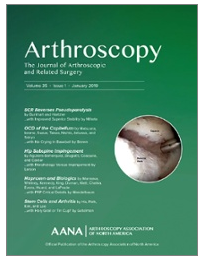As a medical professional, Dr. Carreira actively researches medical procedures and practices within his specialized field of arthroscopy. Through his own practice with Peachtree Orthopedics in Atlanta, and via both MASH Study Group and MASTAF Study Group, Dr. Carreira has committed himself to growing medical knowledge and understanding, and to improving best practices and the standard of care.
Publishing in Arthroscopy, The Journal of Arthroscopy and Related Surgery
Together with his fellow researchers and medical professionals, Dr. Dominic Carreira authored an article that was published in the January 2019 issue of Arthroscopy. The details for this latest publication are below.
Minimal Clinically Important Difference and Substantial Clinical Benefit Values for the 12-Item International Hip Outcome Tool
Robroy L. Martin, Ph.D., P.T., Benjamin R. Kivlan, Ph.D., P.T., John J. Christoforetti, M.D., Andrew B. Wolff, M.D., Shane J. Nho, M.D., M.S., John P. Salvo Jr., M.D., Thomas J. Ellis, M.D., Geoff Van Thiel, M.D., M.B.A., Dean K. Matsuda, M.D., Dominic S. Carreira, M.D.
 The iHOT-12 PROM is a tool to help orthopedic surgeons and other medical professionals. It was designed to be a more concise version of the iHOT-33, an older tool. The iHOT-12 PROM helps surgeons assess the quality and effectiveness of different surgical techniques and procedures when operating in the hip.
The iHOT-12 PROM is a tool to help orthopedic surgeons and other medical professionals. It was designed to be a more concise version of the iHOT-33, an older tool. The iHOT-12 PROM helps surgeons assess the quality and effectiveness of different surgical techniques and procedures when operating in the hip.
While use of the iHOT-33 is helped by studies which deliver evidence for responsiveness and specific information for score interpretation, such evidence is not currently available for the iHOT-12. This new article by Dr. Carreira and his colleagues, sought to evaluate the responsiveness of the iHOT-12 by defining its minimal clinically important difference (MCID), patient acceptable symptom state (PASS), and substantial symptom state (SCB) values. The iHOT-12 was collected from 733 patients who underwent hip arthroscopy for intraarticular pathologies both prior to and roughly one-year post-surgery.
The study provided evidence of responsiveness for the iHOT-12 at the one-year post-surgery time frame. Moreover, the study also provided information to aid in the interpretation of this PROM.
Arthroscopy, 2019. Doi: https://doi.org/10.1016/j.arthro.2018.09.028 Epub 2019 Jan 04
Review this article online


